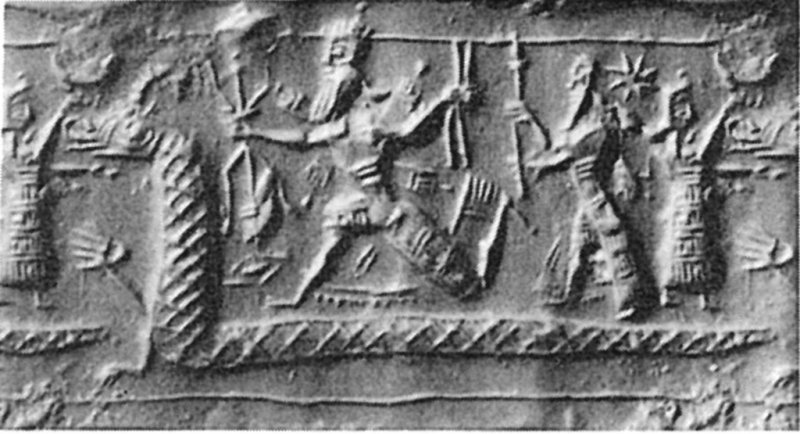It looks like you're using an Ad Blocker.
Please white-list or disable AboveTopSecret.com in your ad-blocking tool.
Thank you.
Some features of ATS will be disabled while you continue to use an ad-blocker.
share:
originally posted by: Kantzveldt
a reply to: Marduk
That's true enough, i figure the European tradition to have started with the Vinca and that was Danube culture, am ancestral Goddess related to the river among other things, Vinca culture did translate to the Ukrainian steppe, and seemingly Danube script to Uruk, as well as Dragons, Bbut then again she's strongly related to the Bosporus and Black sea region.
ušumga meaning great serpent as you pointed out could relate to a dragon, a very large serpent, they have seemingly all known instances of the phrase here which is a good resource., mušhuš is more commonly used but Ningishzida also was associated with the ušumga and understood to have Dragon qualities.
You should not say to Ningishzida: "Let me live!"...Sumerian Proverb
I think it pays to remember at times that the word Dragon comes from the Greeks. And so the appellation of Dragon, isn't that helpful. There were plenty of what we think of as dragons before then, but they all had their own names. So its a bit like saying a cart, a chariot a bicycle and a scooter are all cars...
I have known the great mother for a long time.. yes, even her I have seen in my visions of purity. Dragon Kings and Dragon Queens of ancient days..
great builders and philosopher kings.. high adepts of the three times expertly initiated in the intricacies of the secret magics.. the great
mahāmudrās of a forgotten age, they still tell stories of their hidden land.
My secret benefactor, my master, and my goddess takes the form of a woman with the lower body of a snake. It is not for mortal men to glance at her beauty, she shields her view from the eyes of mortals with a luminous golden silk screen..
This one is evil incarnate indeed, not always mind you - she's very much in love with me for instance. Either way it is not for sentient beings to judge such matters, she is beyond all such critique.
It is not the way of things for their revealments to be perfunctory or arbitrary. If they want to tell you a story they will.
Thank you for this thread by the way, very well put together and interesting as usual.
Oh, and the demiurge thing isn't a delusion.. it is very real. You would know the evil power of that force if you had ever been schizophrenic or experienced years of high strangeness being targeted by negative entities. Reality is very malleable and they have the means to manipulate it to an incredible degree.. the things they could make you go through if they weren't contested.. ever seen that movie The Entity? That was based on a real story.. the demons would rape your mind in your sleep and your body when awake.
As for matter, it is only evil in a certain sense, and if one has experienced the higher realms it's easy to recognise the evil of this lower realm.. sure, there are more hellish places.. but this one can be pretty damn bad, especially if your spirit is not subconsciously used to the horror of the cartoon hells(they're especially bad, trust me on this one).
One of the worst feelings in existence is being golemized and turned into automata in a cartoon hell.. constant pain and they make you sing incredibly disturbing songs. They'll switch it up with some pleasure just to make it worse too, they'll make you think you're free and in heaven with your loved ones until the facade breaks and the terror begins anew. They do that kind of thing hundreds of times over thousands of years to break the spirit. Not a nice place to be in.
My secret benefactor, my master, and my goddess takes the form of a woman with the lower body of a snake. It is not for mortal men to glance at her beauty, she shields her view from the eyes of mortals with a luminous golden silk screen..
This one is evil incarnate indeed, not always mind you - she's very much in love with me for instance. Either way it is not for sentient beings to judge such matters, she is beyond all such critique.
It is not the way of things for their revealments to be perfunctory or arbitrary. If they want to tell you a story they will.
Thank you for this thread by the way, very well put together and interesting as usual.
Oh, and the demiurge thing isn't a delusion.. it is very real. You would know the evil power of that force if you had ever been schizophrenic or experienced years of high strangeness being targeted by negative entities. Reality is very malleable and they have the means to manipulate it to an incredible degree.. the things they could make you go through if they weren't contested.. ever seen that movie The Entity? That was based on a real story.. the demons would rape your mind in your sleep and your body when awake.
As for matter, it is only evil in a certain sense, and if one has experienced the higher realms it's easy to recognise the evil of this lower realm.. sure, there are more hellish places.. but this one can be pretty damn bad, especially if your spirit is not subconsciously used to the horror of the cartoon hells(they're especially bad, trust me on this one).
One of the worst feelings in existence is being golemized and turned into automata in a cartoon hell.. constant pain and they make you sing incredibly disturbing songs. They'll switch it up with some pleasure just to make it worse too, they'll make you think you're free and in heaven with your loved ones until the facade breaks and the terror begins anew. They do that kind of thing hundreds of times over thousands of years to break the spirit. Not a nice place to be in.
originally posted by: Kantzveldt
a reply to: Byrd
What i was basing the Sumerian connection on was a quite common epitaph of Dumuzid as Ama-ucumgal-ana, which literally translates as Mother-Dragon-Heaven (Feminine Ana), a very close association between his Kingship and the Mother Dragon.
What am I missing? When I google for Dumuzid, I come up with male demigods and kings but no females. en.wikipedia.org...
And Ama-ucumgal-ana doesn't seem to be associated with Dumuzid (who is a shepherd deity/king and fertility deity and not a war leader) etcsl.orinst.ox.ac.uk...#
I don't find any association of male fertility gods and kings with "mother dragon" and "ana" refers to the deity, "An".
Could you give me some links?
The most downloaded free game on xbox1 called neverwinter has a 5 headed dragon queen boss named Tiamat.
originally posted by: Byrd
originally posted by: Kantzveldt
a reply to: Byrd
What i was basing the Sumerian connection on was a quite common epitaph of Dumuzid as Ama-ucumgal-ana, which literally translates as Mother-Dragon-Heaven (Feminine Ana), a very close association between his Kingship and the Mother Dragon.
What am I missing? When I google for Dumuzid, I come up with male demigods and kings but no females. en.wikipedia.org...
And Ama-ucumgal-ana doesn't seem to be associated with Dumuzid (who is a shepherd deity/king and fertility deity and not a war leader) etcsl.orinst.ox.ac.uk...#
I don't find any association of male fertility gods and kings with "mother dragon" and "ana" refers to the deity, "An".
Could you give me some links?
Lemme help ya out Byrd.
So its rainy and everyone is home.. annoying me. I yelled out : WHO IS THE DRAGON MOTHER GODDESS??!!
Kid #1 says Daenerys Targaryen ( yeah, had to have her look it up cause I had no damned clue... )
Kid #2 says some crap about minecraft but I cant understand her cause she has a retainer in.. just smile and nod at that one..
Kid #3 says THE CATHOLIC CHURCH ( she is getting a GREAT Xmas present.. )
Kid @2's Fiancee says nothing. I think he is afraid of us all.
Husband says Tiamat
ANd Im whispering this to you... I cant recall the name.. its a Sumerian Goddess of mountains or of sacred mountain.
edit on 17-11-2015 by
Advantage because: (no reason given)
originally posted by: Advantage
originally posted by: Byrd
originally posted by: Kantzveldt
a reply to: Byrd
What i was basing the Sumerian connection on was a quite common epitaph of Dumuzid as Ama-ucumgal-ana, which literally translates as Mother-Dragon-Heaven (Feminine Ana), a very close association between his Kingship and the Mother Dragon.
What am I missing? When I google for Dumuzid, I come up with male demigods and kings but no females. en.wikipedia.org...
And Ama-ucumgal-ana doesn't seem to be associated with Dumuzid (who is a shepherd deity/king and fertility deity and not a war leader) etcsl.orinst.ox.ac.uk...#
I don't find any association of male fertility gods and kings with "mother dragon" and "ana" refers to the deity, "An".
Could you give me some links?
Lemme help ya out Byrd.
So its rainy and everyone is home.. annoying me. I yelled out : WHO IS THE DRAGON MOTHER GODDESS??!!
Kid #1 says Daenerys Targaryen ( yeah, had to have her look it up cause I had no damned clue... )
Kid #2 says some crap about minecraft but I cant understand her cause she has a retainer in.. just smile and nod at that one..
Kid #3 says THE CATHOLIC CHURCH ( she is getting a GREAT Xmas present.. )
Kid @2's Fiancee says nothing. I think he is afraid of us all.
Husband says Tiamat
ANd Im whispering this to you... I cant recall the name.. its a Sumerian Goddess of mountains or of sacred mountain.
I think I'm gonna sit over here in the corner with Kid#2's fiance and... eye you all With Great Suspicion.
a reply to: Byrd
Recorded instanxes of that title as applied to Dumuzid here, he was King of Uruk and Urash the Creat Celestial Dragon Mother which can be determined by the comparisons made of her was a consort of Anu, of Uruk, thus an aspect of Kingship was to rule on behalf of the Great Mother, also Kings of Uruk claimed Ninsumen as their Mother who was the daughter of Urash.
Comparisons of Urash seem generally to be with regards to other Heavenly bodies, Inanna as Venus, Ninurta as Saturn, Utu as the Sun, in visual terms all those could be seen to emerge from her, from beneath the Earth, in Mandaean tradition which developed in Hellenistic Mesopotamia all the bodies of the solar system were understood as the babies of the Great Mother Dragon of Earth known as Ruha, thus a seven headed Dragon could also represent the power of the great Mother within the solar system, and the likes of Ninurta made sure that dragon behaved itself.
It's likely the constellation Hydra as the great Musshu dragon represented the Universal principle.
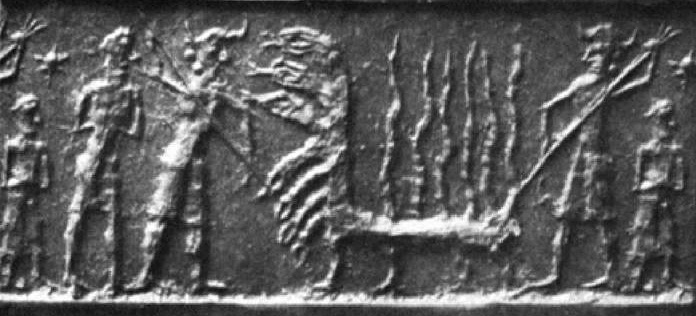
a reply to: TheLaughingGod
Yes death being an aspect of her nature it's necessary to understand the importance of instinctive fear with regards to survival, she cannot help but be dread.
Recorded instanxes of that title as applied to Dumuzid here, he was King of Uruk and Urash the Creat Celestial Dragon Mother which can be determined by the comparisons made of her was a consort of Anu, of Uruk, thus an aspect of Kingship was to rule on behalf of the Great Mother, also Kings of Uruk claimed Ninsumen as their Mother who was the daughter of Urash.
Comparisons of Urash seem generally to be with regards to other Heavenly bodies, Inanna as Venus, Ninurta as Saturn, Utu as the Sun, in visual terms all those could be seen to emerge from her, from beneath the Earth, in Mandaean tradition which developed in Hellenistic Mesopotamia all the bodies of the solar system were understood as the babies of the Great Mother Dragon of Earth known as Ruha, thus a seven headed Dragon could also represent the power of the great Mother within the solar system, and the likes of Ninurta made sure that dragon behaved itself.
It's likely the constellation Hydra as the great Musshu dragon represented the Universal principle.

a reply to: TheLaughingGod
Yes death being an aspect of her nature it's necessary to understand the importance of instinctive fear with regards to survival, she cannot help but be dread.
edit on Kam1130321vAmerica/ChicagoWednesday1830 by Kantzveldt because: (no reason given)
edit on
Kam1130321vAmerica/ChicagoWednesday1830 by Kantzveldt because: (no reason given)
originally posted by: Byrd
originally posted by: Marduk
originally posted by: Byrd
I don't find any association of male fertility gods and kings with "mother dragon"
Not even the obvious one ?
That's not a male fertility god. If you'll check sources, that's Marduk killing Tiamat (unless I'm very mistaken).
Marduk was a male fertility God, his symbol was a spade.
Marduk’s star was Jupiter, and his sacred animals were horses, dogs, and especially the so-called dragon with forked tongue, representations of which adorn his city’s walls. On the oldest monuments Marduk is represented holding a triangular spade or hoe, interpreted as an emblem of fertility and vegetation.
And Tiamat is well known as a mother of dragons
In the Enûma Elish, the Babylonian epic of creation, she gives birth to the first generation of deities; her husband, Apsu, (correctly) assuming they are planning to kill him and usurp his throne, later makes war upon them and is killed. Enraged, she, too, wars upon her husband's murderers, taking on the form of a massive sea dragon, she is then slain by Enki's son, the storm-god Marduk, but not before she had brought forth the monsters of the Mesopotamian pantheon, including the first dragons, whose bodies she filled with "poison instead of blood". Marduk then forms heavens and the earth from her divided body.
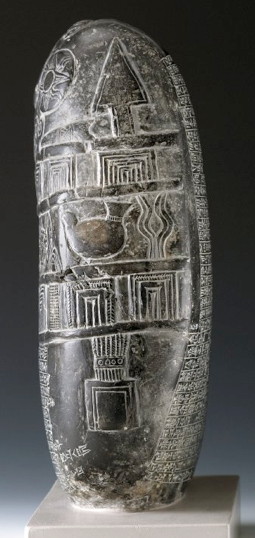
Marduk's symbol, the (triangular) spade, on top of a temple, as seen on the side of a kudurru TT at the British Museum. The relief probably dates to the late 12th century BCE. BM ME 102485
You don't remember Marduk creating mankind from the blood of Kingu ?
Its not often that you're very mistaken is it.
The Mushussu dragon became his symbol because he killed Tiamat, he or his symbol are often depicted with a dragon in a prone position indicating submission. like here for instance
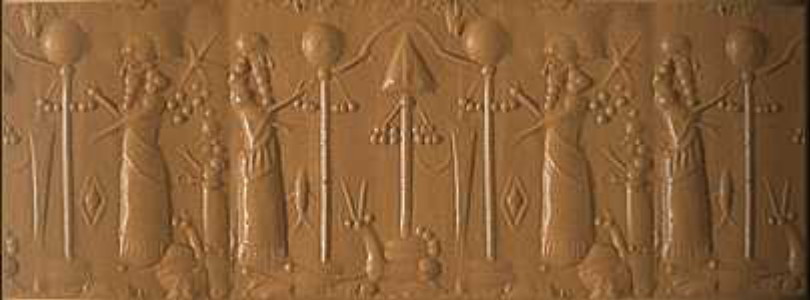
Why do you think the walls of Babylon were covered with dragons, some kind of association going on there probably lol
edit on 18-11-2015 by Marduk because: (no reason given)
originally posted by: Kantzveldt
This cylinder seal dates to 2300bce. It has nothing to do with astrology, your claim that it is the constellation Hydra for instance is not possible as the Hydra myth didn't exist for another 1000 years at least. The Babylonians depicted Hydra as a snake.
It is actually a representation of the same battle between Marduk and Tiamat, the artist has added extra heads to symbolise the rest of her brood which also had to be overcome for Marduk to reign as King of the Gods
I would not be surprised if the Greeks got the idea for the existence of the Hydra in the first place from merchants cylinder seals like this. but as they didn't exist when this was carved, you'd need time travel to prove your assertion
edit on 18-11-2015 by Marduk because: (no reason given)
a reply to: Marduk
No i suggested that Mul-sag-imin represented the seven forces of the solar system, and that Hydra represented the Universal principle of Dragon powers also it is Ningirsu/Ninurta that fought the seven headed dragon in Lugal-e.
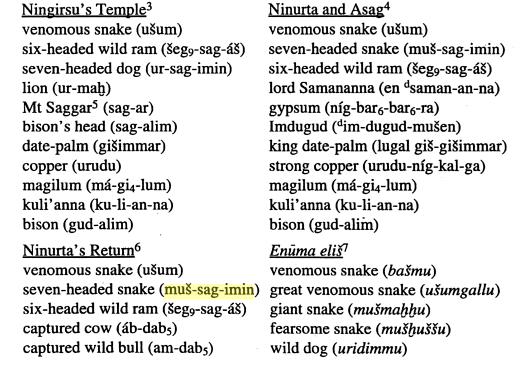
Deliver me from evil
The supposed exploits of Marduk were derivative of the exploits of Ninurta, this here is a good read how the cult of Marduk ripped off that of Ninurta and then how the Hebrews adapted that for their own Apocalyptic literature.
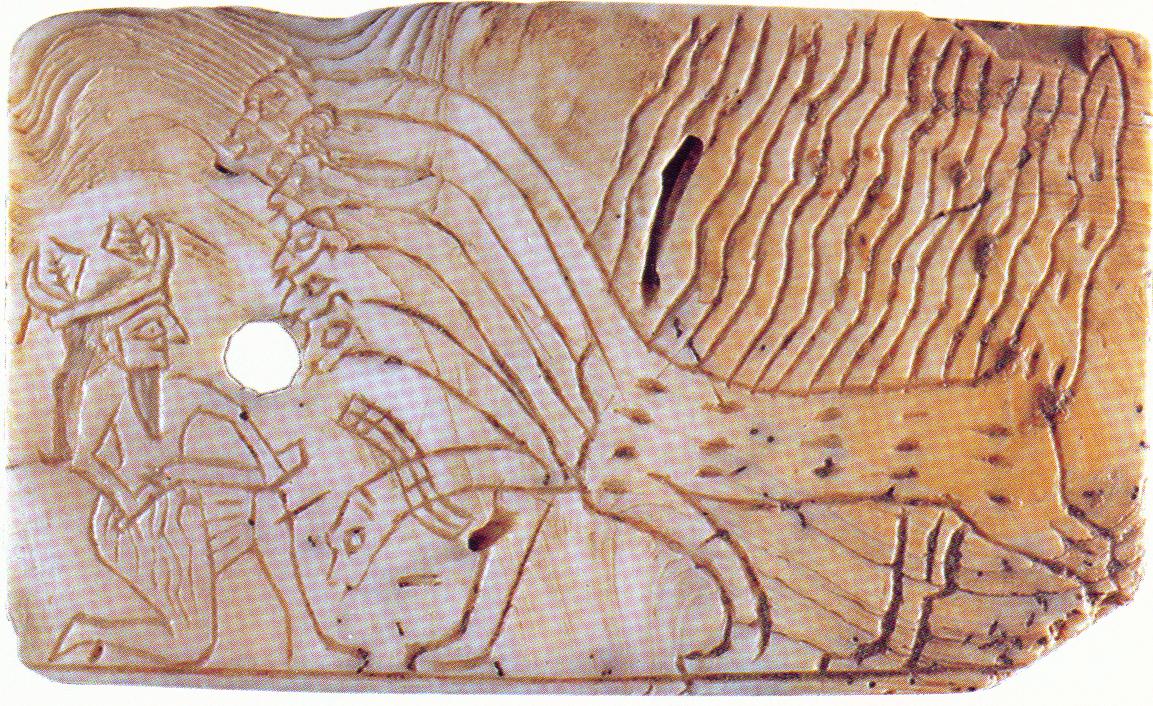
No i suggested that Mul-sag-imin represented the seven forces of the solar system, and that Hydra represented the Universal principle of Dragon powers also it is Ningirsu/Ninurta that fought the seven headed dragon in Lugal-e.

Deliver me from evil
The supposed exploits of Marduk were derivative of the exploits of Ninurta, this here is a good read how the cult of Marduk ripped off that of Ninurta and then how the Hebrews adapted that for their own Apocalyptic literature.
The constant epithet of Marduk in Enuma Elish is Bêl ‘Lord,’ which is also Ninurta’s common epithet, and points to a connection with West-Semitic Baal. Marduk came to replace Enlil in the Mesopotamian pantheon, so he took over conjointly the position of the father Enlil and the mythology of his son Ninurta.

O greatest Ninurta, warrior god, vanguard of the Anunna-gods, commander of the Igigi-gods, judge of the universe, who oversees (its) equilibrium, who makes bright darkness and illumines gloom, who renders verdicts for teeming mankind!
edit on Kam1130321vAmerica/ChicagoWednesday1830 by Kantzveldt because: (no reason given)
you said
Ninurta killed a seven headed serpent, again as I said earlier, using a word invented by the Greeks over a thousand years later as a cover all doesn't help untangle the confusion
Heres a list of the monsters killed by Ninurta
Seven-headed serpent, killed by Ninurta
Bashmu ("venomous serpent"), killed by Ninurta
Mušmaḫḫū ("distinguished serpent"), killed by Ninurta
Ušumgallu ("great serpent")
Anzû, a massive bird whose death was sometimes credited to Ninurta
See a theme there ?
Its pretty obvious that in a land filled with venomous snakes, the snakes are going to get a bad deal in the mythology.
Have you noticed that the myths from other cultures that feature truly massive snakes tend to come from countries that actually have massive snakes.
You'll need to read this, your understanding of the Bel epithet is groundless
Bel meaning
That's what religions always do, when a new God comes to town, he gets all the accolades of the old Gods, consider the Flood story as a great example you are already familiar with.
Or, here's Hercules, ripping off Marduk
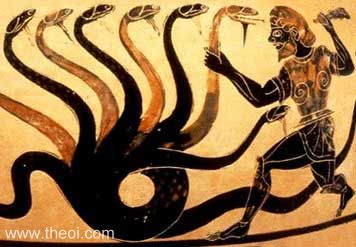
and here's Buddha, ripping off Hercules

It's likely the constellation Hydra as the great Musshu dragon represented the Universal principle.
Ninurta killed a seven headed serpent, again as I said earlier, using a word invented by the Greeks over a thousand years later as a cover all doesn't help untangle the confusion
Heres a list of the monsters killed by Ninurta
Seven-headed serpent, killed by Ninurta
Bashmu ("venomous serpent"), killed by Ninurta
Mušmaḫḫū ("distinguished serpent"), killed by Ninurta
Ušumgallu ("great serpent")
Anzû, a massive bird whose death was sometimes credited to Ninurta
See a theme there ?
Its pretty obvious that in a land filled with venomous snakes, the snakes are going to get a bad deal in the mythology.
Have you noticed that the myths from other cultures that feature truly massive snakes tend to come from countries that actually have massive snakes.
You'll need to read this, your understanding of the Bel epithet is groundless
Bel meaning
the cult of Marduk ripped off that of Ninurta
That's what religions always do, when a new God comes to town, he gets all the accolades of the old Gods, consider the Flood story as a great example you are already familiar with.
Or, here's Hercules, ripping off Marduk

and here's Buddha, ripping off Hercules

edit on 18-11-2015 by Marduk because: (no reason given)
a reply to: Marduk
Snakes didn't get a bad deal in Mesopotamian mythology generally, Ninurta restored order and put down rebellion when aspects of nature got unruly, primarily he maintained balance and order, he was of the opposite side of the Pantheon to the nature Deities so he couldn't let serpents be taking advantage.
The problem with Marduk and Enuma Elish is that there wasn't much prior basis to it in Sumerian culture and it casts archetypes of creation through the waters of life in an entirely negative role, thus leading to the schism were all organic life could be considered evil, the primordial Goddess of ocean was first known as Namma
It's likely to some extent the Babylonians were undermining the traditions of Eridu in portraying the creation through the waters in a negative light, they also credited Marduk with chopping off Anu's head which didn't exactly please the Urukians, if the seven headed serpent represented rebellious astral phenomena related to the planets then Jupiter would certainly be in that number...
The article i quoted saying that like Marduk, Ninurta could simply be referred to as Lord is basically correct, but neither here nor there really as so could other Deities, not my suggestion not so important.
Snakes didn't get a bad deal in Mesopotamian mythology generally, Ninurta restored order and put down rebellion when aspects of nature got unruly, primarily he maintained balance and order, he was of the opposite side of the Pantheon to the nature Deities so he couldn't let serpents be taking advantage.
The problem with Marduk and Enuma Elish is that there wasn't much prior basis to it in Sumerian culture and it casts archetypes of creation through the waters of life in an entirely negative role, thus leading to the schism were all organic life could be considered evil, the primordial Goddess of ocean was first known as Namma
Very little is known about Namma, who belongs to the oldest generation of Mesopotamian deities and is associated with the pantheon of Eridu. She is mainly known for her role in the cosmogony of early Mesopotamia and her importance in magic
Namma is called the "original mother who gave birth to the gods of the universe", again according her primary status among all the gods and describing her role in Mesopotamian cosmogony.
It's likely to some extent the Babylonians were undermining the traditions of Eridu in portraying the creation through the waters in a negative light, they also credited Marduk with chopping off Anu's head which didn't exactly please the Urukians, if the seven headed serpent represented rebellious astral phenomena related to the planets then Jupiter would certainly be in that number...
The article i quoted saying that like Marduk, Ninurta could simply be referred to as Lord is basically correct, but neither here nor there really as so could other Deities, not my suggestion not so important.
edit on Kpm1130321vAmerica/ChicagoWednesday1830 by Kantzveldt because: (no reason
given)
a reply to: Kantzveldt
Your post reminded me of this.
Always excited to see a post from Kantzveldt.
SnF
Your post reminded me of this.
Always excited to see a post from Kantzveldt.
SnF
a reply to: randyvs
Thanks, reminded me of my favorite track involving those clips snd the sad death of Dragon Kings...
Thanks, reminded me of my favorite track involving those clips snd the sad death of Dragon Kings...
She can make the lament for you, my Dumuzid, the lament for you, the lament, the lamentation, reach the desert -- she can make it reach the house Arali
In the desert, my Dumuzi, I sing with her the wail, the wail for you, the wail for you; In the temple Arali I sing with her
Your house of Arali (House which is the nether world) gives shade to the shepherd. Your prince, a raging lion on the plain, the šuba jewel of the Mistress whose breast is holy and marvellous, the lord who is holy Inana’s husband, Dumuzid, the sovereign of E-muš
The son of Ninsumun, was brought to Arali, the pre-eminent place of the Land, in his prime. The soldiers accompanying the king shed tears: their boat was sunk in a land as foreign to them as Dilmun. It was stripped of the oars, punting poles and rudder its bolt was broken off. was put aside; it stood in saltpetre. His donkeys were to be found with the king; they were buried with him. The journey to the nether world is a desolate route.
a reply to: Kantzveldt
On these days
No mans eye has seen the depth of beauty as ours
And yet we trespass against her
We surround her with horrors
On these days
No mans eye has seen the depth of beauty as ours
And yet we trespass against her
We surround her with horrors
originally posted by: Kantzveldt
a reply to: Byrd
Recorded instanxes of that title as applied to Dumuzid here, he was King of Uruk and Urash the Creat Celestial Dragon Mother which can be determined by the comparisons made of her was a consort of Anu, of Uruk, thus an aspect of Kingship was to rule on behalf of the Great Mother, also Kings of Uruk claimed Ninsumen as their Mother who was the daughter of Urash.
Actually, Dragon isn't used as a title in any of those (I modified the search to only return those texts with "dragon") There are four texts where the phrase "like a dragon" occurs, but it's not a title, it's a simile -- i.e. " Ama-ucumgal-ana competes majestically for you in battle, cutting a swathe like a dragon" The same phrase is used for an unnamed messenger the messenger went on his way to Aratta; his feet raised the dust of the road, and made the little pebbles of the hills thud; like a dragon prowling the desert, he was unopposed, "Lament for Sumer" talks about dragons as architectural elements, and "Hymn to Inanna as Ningela" says The levy of troops is brought into the broad square like a crouching dragon.
Could you point to the specific texts where your point is made more clearly? I may have picked up the wrong ones, there.
Comparisons of Urash seem generally to be with regards to other Heavenly bodies, Inanna as Venus, Ninurta as Saturn, Utu as the Sun, in visual terms all those could be seen to emerge from her, from beneath the Earth, in Mandaean tradition which developed in Hellenistic Mesopotamia all the bodies of the solar system were understood as the babies of the Great Mother Dragon of Earth known as Ruha, thus a seven headed Dragon could also represent the power of the great Mother within the solar system, and the likes of Ninurta made sure that dragon behaved itself.
However, as I understand it, Mandaeanism developed only after 100 AD and doesn't really preserve older traditions. The Book I have access to to on Mandaean religion says that Rhua is an evil spirit (a class of demon) and while her son, Ur - who is not associated with a plaet- is a dragon, there's no mention of her as a dragon or as the mother of the Earth. She IS cited as the mother of the planets, though. I don't see that the Earth (Tibil) has a mother.
Would you have a different source I could look at?
new topics
-
Bizarre Labour Party Tic Toc Video Becomes Even More Embarrassing
Regional Politics: 11 minutes ago -
Potter to WHU
World Sports: 5 hours ago -
Dr. Demento
Music: 7 hours ago -
The elephant in the room (wearing a hoodie)
US Political Madness: 7 hours ago
top topics
-
The elephant in the room (wearing a hoodie)
US Political Madness: 7 hours ago, 13 flags -
To become president, Zelensky had to learn Ukrainian
Political Conspiracies: 14 hours ago, 7 flags -
Dr. Demento
Music: 7 hours ago, 6 flags -
Potter to WHU
World Sports: 5 hours ago, 2 flags -
Bizarre Labour Party Tic Toc Video Becomes Even More Embarrassing
Regional Politics: 11 minutes ago, 1 flags
active topics
-
Los Angeles brush fires latest: 2 blazes threaten structures, prompt evacuations
Mainstream News • 189 • : xuenchen -
President Carter has passed
Mainstream News • 48 • : angelchemuel -
Bizarre Labour Party Tic Toc Video Becomes Even More Embarrassing
Regional Politics • 0 • : gortex -
The Fight for Election Integrity Continues -- Audits, Criminal Investigations, Legislative Reform
2024 Elections • 4372 • : IndieA -
What Comes After January 20th
Mainstream News • 35 • : JadedGhost -
Potter to WHU
World Sports • 3 • : gortex -
The Truth about Migrant Crime in Britain.
Social Issues and Civil Unrest • 42 • : gortex -
Post A Funny (T&C Friendly) Pic Part IV: The LOL awakens!
General Chit Chat • 8007 • : underpass61 -
Planned Civil War In Britain May Be Triggered Soon
Social Issues and Civil Unrest • 29 • : AdultMaleHumanUK -
The elephant in the room (wearing a hoodie)
US Political Madness • 19 • : xuenchen

